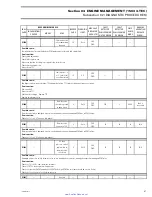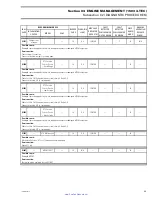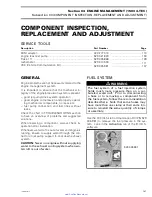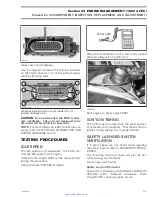
Section 04 ENGINE MANAGEMENT (1503 4-TEC)
Subsection 03 (COMPONENT INSPECTION, REPLACEMENT AND ADJUSTMENT)
Never use
a
battery charger to
substitute
temporarily the battery, as it may cause the
MPEM/ECM to work erratically or not to work at
all. Check related-circuit fuse solidity and condi-
tion with an ohmmeter. Visual inspection could
lead to false results.
WARNING
All electrical actuators (idle bypass valve,
TOPS valve, injectors, fuel pump, ignition
coils and starter solenoid) are permanent-
ly supplied by the battery when the safety
lanyard is installed. Always disconnect the
battery prior to disconnecting any electrical
or electronic parts.
To perform verifications, a good quality multimeter
such as Fluke 111 (P/N 529 035 868) should be
used.
529 035 868
Pay particular attention to ensure that terminals
are not out of their connectors or out of shape.
The troubleshooting procedures cover problems
not resulting from one of these causes.
WARNING
Ensure all terminals are properly crimped on
wires and connector are properly fastened.
Before replacing a MPEM or ECM, always check
electrical connections. Make sure that they are
very tight and they make good contact and that
they are corrosion-free. Check if wiring harness
shows any signs of scoring. Particularly check
MPEM and ECM ground connections. Ensure
that contacts are good and clean. A “defective
module” could possibly be repaired simply by
unplugging and replugging the MPEM or ECM.
The voltage and current might be too weak to go
through dirty wire terminals. Check carefully if
terminals show signs of moisture, corrosion or if
they look dull. Clean terminals properly and then
coat them prior to assembling as follows:
NOTE:
Do not apply dielectric grease or any other
lubricant on the ECM or MPEM connectors.
Other connectors: Apply a silicon-based dielectric
grease or other appropriate lubricant. If the newly
replaced MPEM or ECM is working, try the old one
and recheck if it works.
Ensure that all electronic components are genuine
— any modification on the wiring harness may
lead to generate fault codes or bad operation.
NOTE:
For diagnostics purposes, use Vehicle
Communication Kit (VCK). See DIAGNOSTIC
PROCEDURES subsection.
After a problem has been solved, ensure to clear
the fault(s) in the ECM using the VCK. Refer to
DIAGNOSTIC PROCEDURES subsection.
Resistance Measurement
When measuring the resistance with an ohmme-
ter , all values are given for a temperature of 20°C
(69°F). The value of a resistance varies with the
temperature. The resistance value for usual re-
sistor or windings (such as injectors)
increases
as the temperature increases. However, our tem-
perature sensors are NTC types (Negative Tem-
perature Coefficient) and work the opposite which
means that the resistance value
decreases
as the
temperature increases. Take it into account when
measuring at temperatures different from 20°C
(69°F). Use this table for resistance variation rel-
ative to temperature for temperature sensors.
smr2005-013
109
www.SeaDooManuals.net
















































